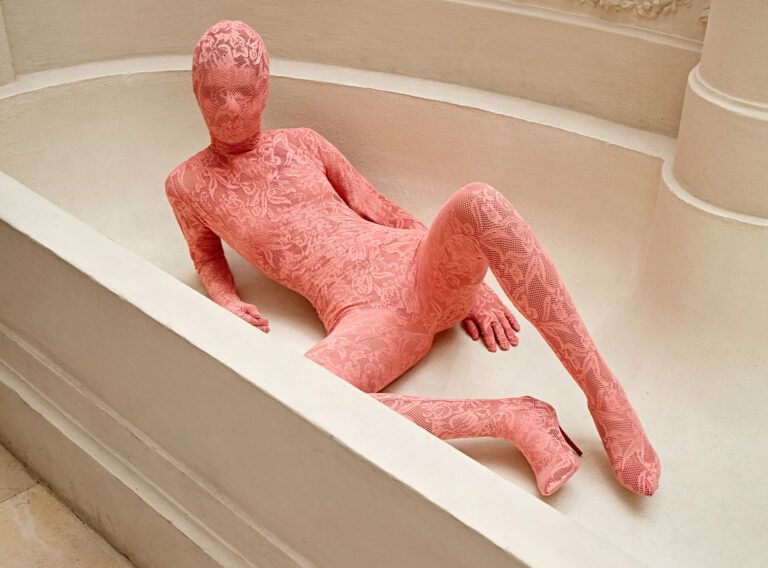How does the summer season inspire your artistic process?
That’s a good question. I guess, during this time, I’m drawn to vibrant and saturated colour palettes. Last year around this time, I started to work on a project inspired by the toy Polly Pocket, which now has been realised. I would say summer allows me to explore projects that are playful and filled with life.


Recycling is a big part of your art. You work with discarded ropes, recycled PET yarn or salvaged yarn. What are the unique qualities or characteristics of these recycled materials that attract you as an artist?
Using waste materials plays indeed a significant role in my art. When I first started working with ropes, I utilized their roughness and natural attributes. However, as I incorporated different types of yarn, the rope transformed into an entirely different, soft and supple material. Sourcing materials from harbours and scraps adds an inspiring aspect to my work, although it does require me to adapt my creative process based on what’s available. It sometimes directly effects a project because I have to readjust my way of working on what is actually available at the moment of creation.



In what ways do you believe using recycled materials enhances the message of your art?
The use of recycled materials enhances the message of my art in several ways. Initially, when I focused on marine waste, the material itself became an integral part of conveying the message. However, over the years, my concept evolved, and now the recycled materials allow me to tell stories that are independent of their original context of the sea and the fishery sector.


The exhibition “𝘐𝘧 𝘠𝘰𝘶 𝘒𝘯𝘰𝘸 𝘞𝘩𝘰 𝘚𝘩𝘦 𝘐𝘴, 𝘐𝘵‘𝘴 𝘛𝘪𝘮𝘦 𝘧𝘰𝘳 𝘉𝘰𝘵𝘰𝘹” draws inspiration from Polly Pocket. Can you explain how 90s aesthetics are represented in your artworks and what message or feeling you aim to convey to viewers?
I would first like to introduce Polly Pocket to those who are maybe not familiar with the toy. As a child of the 90s, I can still recall the widespread craze that surrounded Polly Pocket when the toy line was at the height of its popularity. It actually started as a tiny toy house, which you could carry around in your pocket – therefore also the name – which came along with the miniature doll, Polly. The houses were often heart or star-shaped and many girls imagined themselves in a world within that small house. After a few years, Polly Pocket evolved into a Barbie-like doll, but in a smaller size. These dolls allowed you to collect various clothing items and accessories.
The exhibition “If You Know Who She Is, It’s Time for Botox” draws inspiration from Polly Pocket as a character and embodies 90s, or better an early 00s aesthetics. In my artworks, I aim to represent this aesthetic by recreating life-size versions of Polly’s clothes and accessories. The installation aims at evoking the feeling of growing up alongside the toy. By entering the Polly Pocket universe, I aim at providing an experience that is built on the intersection between real life and the toy’s realm, evoking nostalgia and a sense of a phantastic world and wonder.



Your recent artwork involves clothing. I’d like to know how your connection with fashion influences your artistic creations. How does your relationship with clothing impact your creative direction?
Although my recent artwork involves clothing, my connection with fashion didn’t initially inspire the work. Instead, the inspiration stemmed from a Polly Pocket meme I encountered on social media. The meme featured Polly Pocket and her accessories. The image was captioned, “If you know who she is, it’s Time for Botox,” which is now the title of my solo exhibition.
However, what intrigues me especially is the juxtaposition of the digital and the crafted. The process itself, particularly the labour-intensive stitching of ropes together, results in an outcome that aims at resembling a 3D print rather than a handmade object. This seems especially interesting to me because my main reference point – the meme – lies in the digital realm, whereas the outcome is a handcrafted object. Then again, the aesthetics of the object aims at bridging the gap between the digital and the crafted.

As a designer, do you envision fashion differently in the far future?
Of course! Especially in this era when technology and AI develop at a fast speed. I always believe that fashion will continue to intertwine with technology, becoming increasingly adaptive and personalized. Sustainability will also become more central, with materials and manufacturing processes becoming more eco-friendly. So, I envision a future where fashion is technologically advanced, sustainably crafted, and highly personalized.





